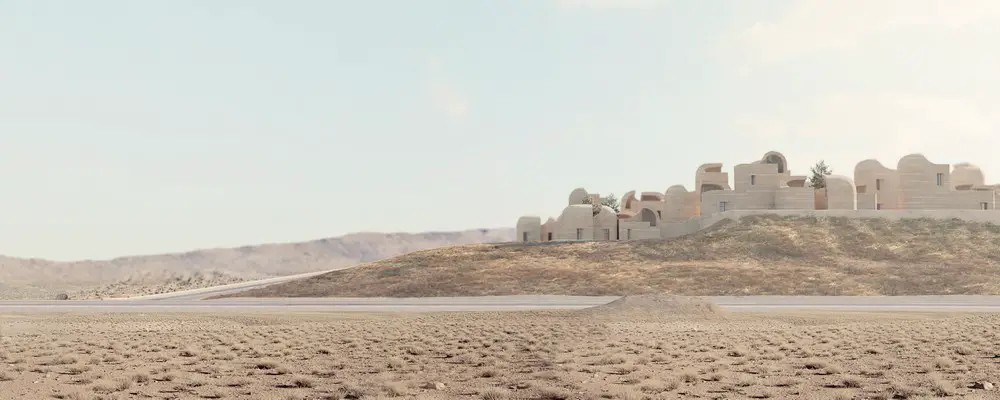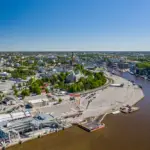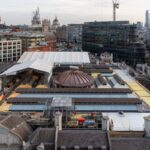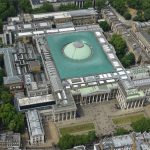Tehran Design Competition, Building Contest Iran, Architect Winner Info, Asia Architecture News
Iran Design Competition : Building Information
Contemporary Iranian Contest organised by Benetton
Iran Design Contest
Benetton Group promotes: “Designing in Teheran”
Teheran Design Competition Winners
Grzegorz Witold Woronowicz (Project A)
Yana Radera (Project B)
now to be announced 8 Jun 2009 (originally 20 Apr 2009)
Deadline for entry : passed
Teheran Design Competition – International Architecture Contest
Contest announcement
Description of the initiative (hereafter the “Contest”) 1.
Designing in Teheran is an international contest open to creatives, designers and architects, who are called upon to develop a design for two multistorey buildings, hereafter A and B, set in the Iranian city of Teheran.
The aim of the Designing in Teheran contest is to bring together ideas and identify solutions that will provide the best and most coherent integration of the structures in the local urban and commercial setting, with projects that take into account cultural and technical aspects, in order to enhance the buildings, making them recognisable, with a clear sense of identity. The spaces in question will be used for commercial premises and offices, and crucial in these designs will be the ability to convey the sense that these spaces are interpreted with contemporary sensitivity.
The Tehran Design Contest will select three designs for A and three for B, before going on to proclaim one winner for A and one for B.
Brief 2.
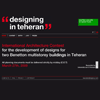
www.benettongroup.com/designinginteheran
Teheran – a brief history:
Teheran in Persian means “going downwards”. Indeed, the ancient city was first established on an upland plateau before gradually developing downhill in subsequent years to become the metropolis it is today.
Expansion of the city was rapid and uncontrolled, but unlike in other cases of massive development, the wealthy population moved out of the old town, whilst the poorer classes remained there.
Teheran now has over 11 million inhabitants and is the country’s main industrial, political and socio-cultural centre.
The quality of the spaces in the modern city is seen in its architecture and monuments, and in its environmental fabric as a whole. Large buildings, monuments and streets, together with modern communication and information systems, combine to give Teheran a sense of modernity, and to enable it to renew itself over time, in order to meet changing functional, creative and artistic needs.
Thus we should consider these buildings as modern communication tools that take into account the commercial requirements of different types of activities. One of these activities has to do with the big names in the fashion world and the competition between them, which manifests itself in the innovative environmental quality of their retail spaces, rich in new messages and cultural ideas.
The “Designing in Teheran” contest seeks to stimulate innovative ideas that will convey these messages of modernity and attention to the architectural and environmental quality of the retail spaces in a constantly evolving metropolis.
Object of the contest 3.
The object of the contest is to design, in the senses and terms of these regulations:
a multistorey building A located in Teheran, at No. 1742, corner of Salmak St., Vali Asr Ave., Tajrish Sq., in about 1500 m² lot, comprising twelve floors (including four below ground level). The gross floor areas and intended use of each floor are as follows:
– Underground levels from -4 to -2, 1200 m² each, for use as car parking space
– Underground level -1, 1200 m² for use as car parking and storage space (in equal proportions)
– Ground level and first floor, 1200 m² each, subdivided into 3 commercial units, each spanning both floors
– Floors second to fourth, 900 m² each, for use as office space
– Floors fifth to sixth, 675 m² each, for use as office space
– Seventh floor, 675 m², for use as apartments
a multistorey building B located in Teheran, at Vali Asr Ave., 800 metres to the south of Vanak Square, in about 1500 m² lot, comprising twelve floors (including four below ground level). The gross floor areas and intended use of each floor are as follows:
– Underground levels from -4 to -2, 1200 m² each, for use as car parking space
– Underground level -1, 1200 m² for use as car parking and storage space (in equal proportions)
– Ground level and first floor, 1200 m² each, subdivided into 3 commercial units, each spanning both floors
– Floors second to fourth, 900 m² each, for use as office space
– Floors fifth to sixth, 675 m² each, for use as office space
– Seventh floor, 675 m², for use as apartments
As one can deduce from the plans, at the moment the land plot consists of a front of 50 linear metres and a width of 30 linear metres.
Candidates are free to choose the architectural elements in their plans, working from the reference volume indices provided. They must provide the volumetric plans of the chosen building and area, with a more detailed plan of a sample floor for office use.
Specifically, they should provide the following planning documents both for building A and for building B:
– rendering of the building;
– distributional layout of vertical circulation and access from the ground floor to the office areas;
– internal rendering of office areas;
– layout of a sample office floor subdivided into 3 or 4 offices per floor, with precise indications of the type of partition structures to be used.
Participants 4.
The contest is open to all natural persons aged 18 and over; there are no exclusions to access based on the possession of specific professional qualifications or geographical origins or of any kind, other than those specified as follows.
Excluded from participation are all members of the Jury (see article 10 below), their family members and acquired relatives; all members of the Supervisory Committee (see article 11 below), their family members and acquired relatives; those who have permanent working relations with members of the Jury or Supervisory Committee; those involved in the organisation of this contest.
Entry and participation 5.
Entry and participation in the Teheran Design Competition are possible exclusively by registering on the website www.benettongroup.com/designinginteheran, filling out the entry form (building A, building B or both) and uploading the required planning documents, following the technical instructions provided.
The candidate will then receive an e-mail to confirm that the entry has been accepted and the planning documents received.
The Teheran Design Competition opening date for entry is 15.12.2008
All planning documents must be delivered strictly by midday (C.E.T), 27.03.2009. Entries arriving after this time will not be accepted.
The Teheran Design Competition winners will be announced by 20.04.2009
Planning documents 6.
Planning documents should be produced in English in .pdf format, organised as follows:
– a one-page document in Word, illustrating planning choices and logic;
– a summary sheet measuring 70 x 100 cm, with architectural sketches;
– two 70 x 100 cm sheets of drawings of the project (plans, elevations, cross-sections, renderings, materials and construction details);
Identification and anonymity 7.
All planning documents and other materials produced as in part 6 above, will be presented to the Jury in anonymous form, and must not contain any element that might reveal the identity of the author as this will lead to automatic exclusion from the contest.
At the time of entry, an alphanumeric code will be assigned to each entrant, and all planning documents and materials will be identified using this code, thus ensuring full anonymity.
Requirements for admission of planning documents 8.
All planning documents must be delivered by the closing date specified in part 5 of these regulations.
The planning documents delivered by the above time will be evaluated by the Jury only if they are complete with all the items mentioned in part 6 of these regulations.
Jury 9.
The Teheran Design Competition Jury consists of 7 members with voting rights. The Jury’s decisions are taken on the basis of a simple majority. In order for a decision to be valid, all Jury members must be present. Each Jury member expresses a single vote.
Teheran Design Competition Jury members:
– Odile Decq, architect (President)
– Tobia Scarpa, architect
– Cino Zucchi, architect
– Makio Haksuike, architect
– Luis Pereira, architect
– Tatiana Sambo, architect (Retail Design Manager – Benetton Group spa )
– Michele Zanella, engineer (Property Management Director – Benetton Group spa )
The Jury’s decision is final.
No item 11!
Criteria for judgement 10.
The jury will evaluate entries according to the following criteria:
– the originality and innovative impact of the design;
– eco-sustainability;
– the overall cultural impression expressed through the design;
– economic consideration, seen in the appropriate use of technology, components and materials.
Prizes 12.
The total prize money is Euro 30,000.00 for each building.
The winner for A and the winner for B will be awarded Euro 20,000.00 each.
The remaining two finalists for each building (four finalists), will be awarded Euro 5,000.00 each.
Should the contest, for any reason, end without a classification of merit or without winners, the Jury will divide the total prize money between the designs considered worthy of recognition. If the same person wins for both A and B, the prize money will be combined.
Terms of participation 13.
Participants in the contest declare and guarantee that the planning documents presented are:
– solely their own, as regards both copyright and exploitation rights, and thus that no third party has any property rights over them;
– original and each single participant’s own personal work;
– new, and thus that they are not alterations or reproductions of images and planning documents taken from other people and/or sources.
Participants acknowledge that the organiser and its assignees are thus exonerated from all responsibility for any disputes regarding the originality and paternity of the works.
By registering on the above website and sending their materials to the contest organisers, participants express their unequivocal and full acceptance of the content of these regulations, and their consent for the processing of their personal details, as described in part 16.
Rights of use 14.
By the payment of prizes to the winners and the remaining finalists, Benetton Group acquires all property rights and remaining rights specified in Italian law 633 of 1941, over planning documents, drawings, plans, works and anything else produced by the three finalists for A and the three finalists for B for participation in the contest.
Benetton Group may transfer these rights to Italian companies interested in the projects, and may promote the projects to Italian and foreign companies.
Should Benetton Group or other parties become interested in exploiting non-winning entries from “Designing in Teheran” for commercial, communicative and/or construction purposes, they undertake to enter private negotiations with the authors.
Furthermore, the finalists authorise Benetton Group and its assignees to publish their designs in catalogues, books, specialist magazines or other means of mass communication. The participants will be owed nothing for this publishing. Benetton Group is nonetheless obliged to name the author of the work.
Results/Publications 15.
The contest organisers undertake to announce the results of the contest by whatever means they consider most suitable.
The organisers will communicate the results of the contest to all participants at the time specified in these regulations, through the website www.benettongroup.com/designinginteheran. The website will also publish pictures of the six finalists, three for building A and three for building B.
Privacy 16.
Personal data regarding each participant will be processed by Benetton Group (data controller) for the sole purpose of allowing participation in the contest and of carrying out related activities, as described above.
The data may be processed both in hard copy and by electronic means. Provision of the data required for the purposes of participation in the contest is obligatory, and for this reason, failure to provide this data or to give consent for its processing may prevent entrants from participating in the contest, and prevent the organisers from carrying out all the related activities.
In line with the above specifications, the data provided may be subject to disclosure.
The data provided will be handled for the duration of the contest and afterwards for the fulfilment of all the activities specified in these regulations.
Participants may exercise their rights as laid down in article 7 of Italian Decree N°. 196/2003.
Applicable law and court of jurisdiction 17.
The Teheran Design Competition will be regulated by Italian law; any controversies shall be referred to the Milan Courts, which shall have sole jurisdiction.
Location: Teheran, Iran
New Iran Architecture Designs
Contemporary Architecture in Iran
Iran Architecture Designs – chronological list
Contemporary Iranian Buildings Selection
Barin Ski Resort
Design: RYRA Studio architects
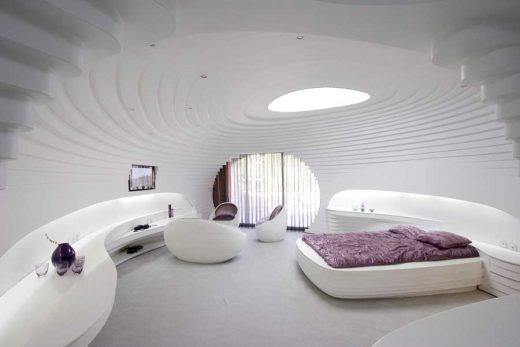
image Courtesy architecture office
Barin Ski Resort
White Office Building, Tehran, Northern Iran
Architects: BNS Studio
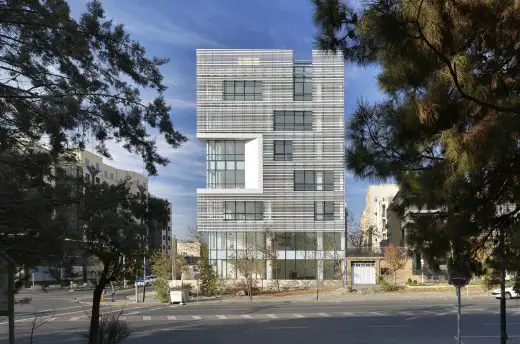
photos : Farshad Kazerooni, Azin Soltani
White Office Building in Tehran
Teheran Design Competition Jury member : Odile Decq
Comments / photos for the Tehran Design Competition Architecture page welcome

